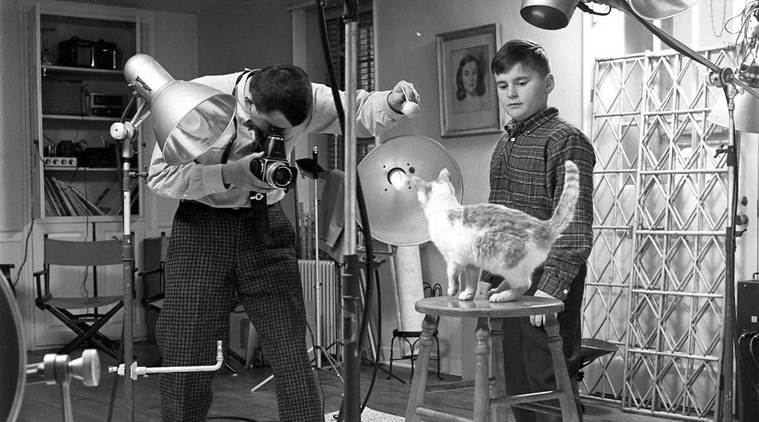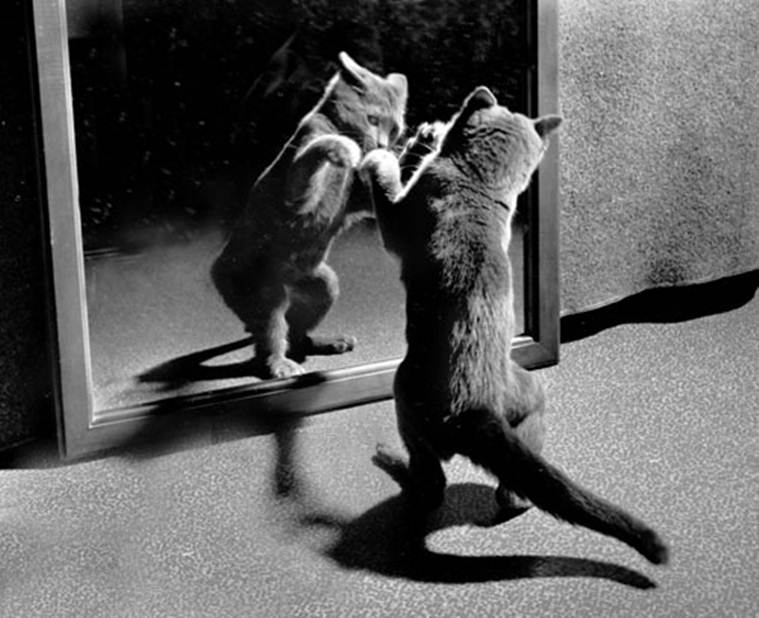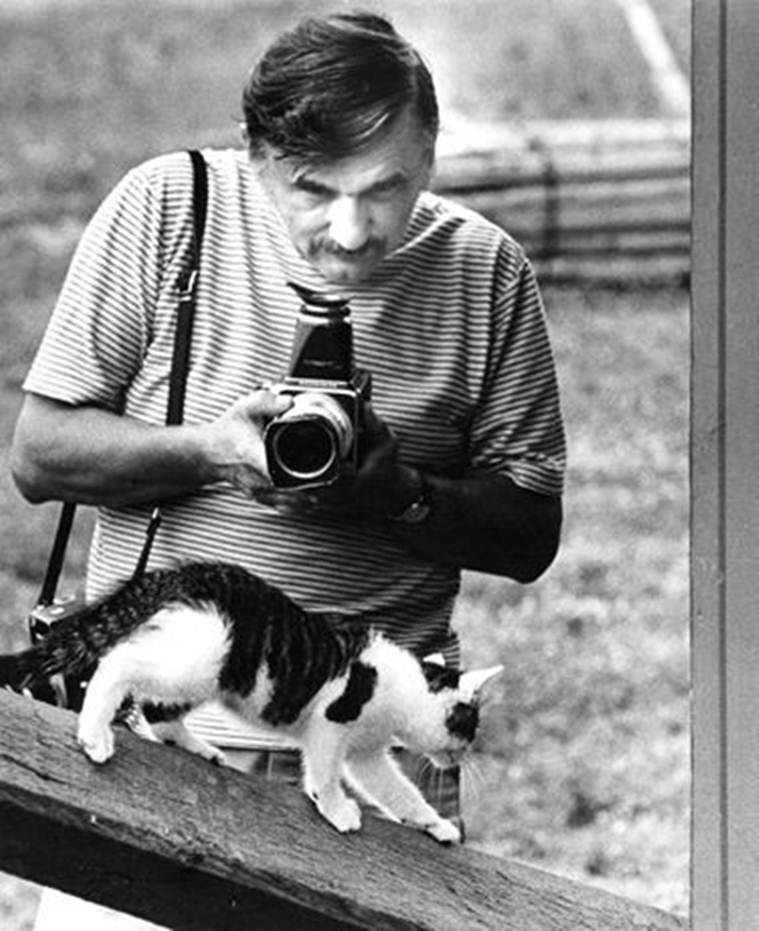- India
- International
Walter Chandoha, photographer who took 90,000 cat pictures, dies
By the time he died on January 11, Walter Chandoha had taken some 90,000 cat photos, nearly all before cats had become viral darlings of social media. He was 98.
 Walter Chandoha with his son Enrico and a subject in his home studio in 1961. (Walter Chandoha Archive via The New York Times)
Walter Chandoha with his son Enrico and a subject in his home studio in 1961. (Walter Chandoha Archive via The New York Times)
Written by Richard Sandomir
On a winter’s evening in 1949, Walter Chandoha was walking to his three-room apartment in Astoria, Queens, when he spotted an abandoned gray kitten shivering in the snow. He put it in a pocket of his Army coat and brought it home to his wife, Maria.
The kitten’s antics — racing through the apartment each night as if possessed, shadowboxing with his image in a mirror — inspired the couple to name him Loco. Chandoha (shan-DOE-uh) was moved to photograph Loco and quickly sold the pictures to newspapers and magazines around the world.
Taking pictures of cats soon began to look like a more fulfilling career path than the one in advertising that Chandoha had planned while attending New York University, after serving in World War II. So, after graduating, he turned to freelance photography for a living — and by the mid-1950s, he had begun a long period as the dominant commercial cat photographer of his era.
“Walter Chandoha’s cat models, shown on this page, must be alert, graceful and beautiful,” read a newspaper ad in 1956 for a cat food brand that featured his photos. “To keep them that way, Mr. Chandoha feeds them Puss ‘n Boots because Puss ‘n Boots is good nutrition.”

By the time he died, on Jan. 11, Chandoha had taken some 90,000 cat photos, nearly all before cats had become viral darlings of social media. He was 98.
 A photo taken by Walter Chandoha of his cat Loco in 1949. Pictures of Loco, a stray kitten he found in the snow, launched Chandoha’s unexpected career as a cat photographer. (Walter Chandoha via The New York Times)
A photo taken by Walter Chandoha of his cat Loco in 1949. Pictures of Loco, a stray kitten he found in the snow, launched Chandoha’s unexpected career as a cat photographer. (Walter Chandoha via The New York Times)
His daughter Chiara Chandoha said he died at his home in Annandale, New Jersey, where his last cat, Maddie, a brown, beige and black tabby, followed him everywhere.
Although Chandoha photographed dogs, horses and other animals, he is known primarily for his cat pictures, which appeared in magazines like Life and National Geographic, on the cans of myriad brands of cat food, in calendars and in books like “Walter Chandoha’s Book of Kittens and Cats” (1963) and “How to Photograph Cats, Dogs and Other Animals” (1973).
“Once upon a time,” Carey Dunne wrote in 2016 in an article for Hyperallergic, an arts and culture website, “there was but One Cat Photographer to Rule Them All. His name was Walter Chandoha.”
Chandoha grew up with cats — they chased mice away at his family’s grocery store in Bayonne, New Jersey — and felt that their personalities made them ideal subjects for photographs.
 A photo provided by the Walter Chandoha Archive shows the photographer at work in 1977. (Walter Chandoha Archive via The New York Times)
A photo provided by the Walter Chandoha Archive shows the photographer at work in 1977. (Walter Chandoha Archive via The New York Times)
“You’d never get the same expressions with dogs,” he said in an interview for the book “Walter Chandoha: The Cat Photographer” (2015). “Cats are just naturally expressive. They get in such a variety of situations.”
Chandoha’s studio photos — distinguished by backlighting that accentuated his subjects’ profiles — portrayed cats and kittens in solo portraits and group shots as infectiously adorable and unusually well behaved. But, cats being cats, they needed cajoling to stay in place long enough to be captured sitting atop a pile of pillows, playing with a ball of yarn, staring plaintively into the lens or appearing to chuckle or snarl.
It fell to Maria Chandoha to handle the cats for the photo shoots in their home studios, in Huntington, New York, and later in Annandale.
“Maria would hold them in position, and I would be behind the camera making all sorts of sounds,” he said in a video interview for The New York Times Magazine in 2014. “I’d bark and meow to get the animals’ attention. Maria could tell by the muscular tension in the animals themselves whether they were relaxing, and when I saw something of interest happening, I’d say, ‘Maria, go!’ and she’d take her hands away.”
Chiara Chandoha recalled that her parents borrowed kittens and cats from the local chapter of the ASPCA.
“We’d feed them first, and my mom would ask me to keep handing her kittens and she would put them on a stool,” she said in a telephone interview. “While he was looking through the viewfinder, she’d distract them with a feather or a noise. Sometimes you’d get the shot in 10 minutes, sometimes in two days.”
Walter George Chandoha was born in Bayonne on Nov. 30, 1920. His parents, Sam and Pauline (Tychy) Chandoha, were Ukrainian immigrants.
Walter began taking pictures with his family’s folding Kodak camera. He learned the fundamentals of darkroom work at the Lens Club in Bayonne. A $12-a-week job after high school as a photographer’s assistant in Manhattan further developed his photographic and darkroom skills.
After being drafted into the Army, he became a press photographer for the weekly newspaper at Fort Dix, in New Jersey, and then served as a combat photographer in the South Pacific. After his discharge, he attended the NYU School of Commerce, Accounts and Finance (now the Leonard N. Stern School of Business) on the GI Bill. In his spare time he photographed New York City street scenes, including some well-known ones taken at the old Pennsylvania Station.
In 1949 he married Maria Ratti, met Loco and graduated. His cat pictures won contests — in one case he took home a $10 prize from The Brooklyn Eagle for a shot of two kittens appearing to escape over a wall — and were seen in various newspapers. His early success led him to resign after three weeks from a job taking pictures for college yearbooks.
“We starved for two years, were happy,” he said in an interview in 2011 with Photographers Speak, a blog, “and although I did not realize it at the time, we were building a stock picture file that is still yielding today, some 50 years later.” (He built an archive of more than 225,000 photographs.)
One of his best-known pictures, “The Mob,” was shot outside his studio. It depicts five determined-looking cats walking on his farm in Annandale, as if looking for trouble. “It was about time for dinner, and I called ‘Kitty, kitty, kitty,’ and all the cats came running,” he told CNN in 2016.
When they slowed down, he dropped to his stomach and captured their fleeting tough-cats-in-the-countryside moment.
Another popular photo, which was used for greeting cards, showed his daughter Paula, then 6 years old, smiling, her mouth missing some teeth, and a kitten perched on her shoulder.
After his wife’s death in 1992, Chandoha focused increasingly on outdoor photography. Heartbroken, he felt he could no longer work in his studio without her; he began to take pictures of his garden and the outdoor cats on his 46-acre property. With his wife’s guidance — she had a degree in botany from Rutgers University — he had been growing berries and vegetables for years, partly as a hedge against his freelance income.
In addition to his daughter Chiara, Chandoha is survived by his daughters, Paula Chandoha Amaral, Maria Valentino and Fernanda Chandoha; a son, Sam; and three grandchildren. Another son, Enrico, died in 1997.
Until shortly before his death, Chandoha had been working on a retrospective book of 300 of his cat photographs, some of cats with dogs. It will be published this year by Taschen, the art-book publisher.
“He was a freak of nature,” Fernanda Chandoha said in a telephone interview. “He had congestive heart failure, but that was manageable. He was always doing something. He was working on the foreword to the Taschen book until nearly the end.”
Best of Express

Buzzing Now
Apr 16: Latest News
- 01
- 02
- 03
- 04
- 05





































